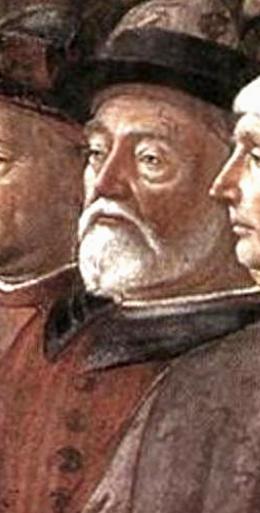John Argyropoulos facts for kids
Quick facts for kids
John Argyropoulos
|
|
|---|---|

John Argyropoulos as depicted by Domenico Ghirlandaio in 1481 in the Vocation of the Apostles fresco in the Sistine Chapel, Rome.
|
|
| Born |
Ioannis Argyropoulos
c. 1415 |
| Died | 1487 |
| Nationality | Greek |
| Education | University of Padua (Theol. Dr., 1444) |
| Era | Renaissance philosophy |
| Region | Western philosophy |
| School | Renaissance philosophy Aristotelianism |
| Institutions | University of Constantinople (1448–1452) Neoplatonic Florentine Academy (1456–70) |
|
Main interests
|
Rhetoric, theology |
|
Influences
|
|
|
Influenced
|
|
John Argyropoulos (born around 1415 – died June 26, 1487) was an important Greek teacher, philosopher, and humanist. He was one of the many Greek scholars who moved to Italy. These scholars played a big part in bringing back the study of ancient Greek knowledge during the Italian Renaissance.
He translated many Greek philosophical and religious books into Latin. He also wrote his own works about speaking well (rhetoric) and religion. John Argyropoulos lived in Italy from 1439 to 1444 for the Council of Florence. He returned to Italy after his home city fell in 1453. He taught in Florence from 1456 to 1470 and in Rome from 1471 until he died.
Contents
John Argyropoulos's Life Story
John Argyropoulos was born around 1415 in Constantinople. This city was the capital of the Byzantine Empire. There, he studied deep subjects like religion and philosophy.
Early Life and Studies
As a teacher in Constantinople, Argyropoulos had many students. One of his famous students was the scholar Constantine Lascaris. John Argyropoulos also worked for one of the rulers of the Byzantine area called Morea.
In 1439, he joined the Byzantine group at the Council of Florence. This was a big meeting where they agreed to accept Catholicism. They moved away from Greek Orthodoxy for a time. In 1443 or 1444, he earned a special degree. It was a Doctor of Theology from the University of Padua in Italy. After this, he went back to Constantinople.
Moving to Italy
In 1453, a very important event happened. The city of Constantinople was captured. This event is known as the Fall of Constantinople. It was taken by the Ottoman Empire. After this, John Argyropoulos left his home city. He moved to the Despotate of the Morea, which was still free.
Then, in 1456, he found safety in Italy. He became a teacher there. He helped bring back the study of Greek philosophy. He led the Greek department at the Neoplatonic Florentine Academy in Florence.
Teaching in Rome
In 1471, a serious illness called the plague broke out. Because of this, he moved to Rome. He kept teaching Greek there until he passed away.
Famous Students and Works
Many important people were his students. These included Pietro de' Medici and Lorenzo de' Medici. Lorenzo was a powerful leader in Florence. Other students were Angelo Poliziano, Johann Reuchlin, and Jacques Lefèvre d'Étaples. Some people also say that Leonardo da Vinci was his student. However, there is no clear proof of this.
John Argyropoulos worked hard to bring Greek philosophy to Western Europe. He did this by translating many Greek works into Latin. Many of these were works by the famous philosopher Aristotle.
His main translations included Aristotle's Categoriae (Categories) and Physica (Physics). He also translated Metaphysica (Metaphysics) and Ethica Nicomachea (Nicomachean Ethics). These books covered many topics. They included logic, nature, and how to live a good life. He also wrote his own explanations of Aristotle's ethics. Some of his writings still exist today as old manuscripts.
John Argyropoulos died on June 26, 1487, in Florence. It is said that he died because he ate too much watermelon.
See also

